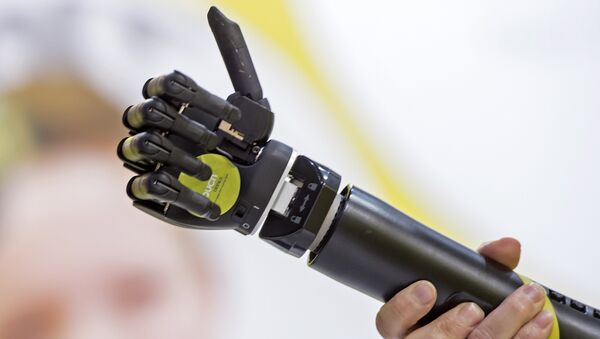The new development will be used to create exercise equipment for those in rehabilitation, smart clothes for athletes that can take electrocardiograms as well as monitor other indicators, and a system to control bionic arm prostheses. It can also be used for remote control of smartphones and Smart House systems.
Myo Interface is a project of a human-computer interface that reads the arm muscles' electric activity, recognizes gestures and translates them into commands for devices, explained Bulat Aitbayev, master's degree student at MEPhI's Higher Engineering School.
"Myo comes from ‘muscle' in Greek," Aitbayev told an RIA Novosti representative. "The electrodes read the electromyographic signals of the muscles, while the interface uses special algorithms to recognize movement patterns and translate them into device commands."
This project has been underway since 2015. Myo Interface won FASIE's Start-1 grant worth two million rubles; this money was used to assemble the laboratory prototype capable of recognizing up to eight gestures.
READ MORE: 'Bionic Beauty': Girl With Prosthetic Leg Comes Third in Miss Italia (PHOTOS)
Recently, the developers have assembled a brand new, autonomous version of the device, which looks like a wristband equipped with Bluetooth and power supply modules, and also has an inertial module that includes a gyroscope and accelerometers.
"Compared with the analogues, our device has a higher accuracy and lower device recognition delay rate," Aitbayev explained. "It also allows the use of a wider range of various recognition algorithms."
Researchers also managed to solve the subject of recognition algorithms, which used to stop working upon removing and attaching the electrodes back again; this allowed the reduction of the preliminary adjustment time. In the future, developers are planning to register their intellectual property and find industrial partners to implement the project.
READ MORE: Second Sight: Russian Docs Install First Bionic Eye Implant in Blind Patient
The new MEPhI design can be used to create exercise equipment for those in rehabilitation after strokes or other traumatic situations that cause temporary paralysis; to make smart clothes for athletes that can take electrocardiograms or electromyograms, as well as monitor other health indicators. It can also be used for remote controlling various devices, such as smartphones or Smart House systems.





